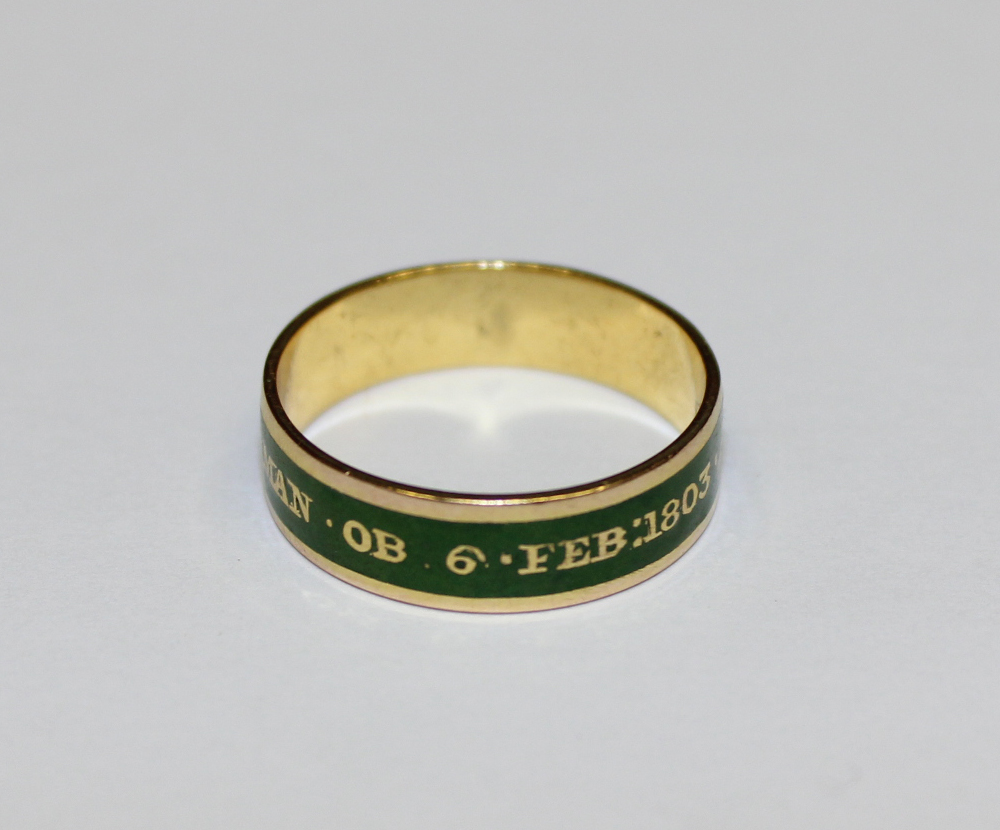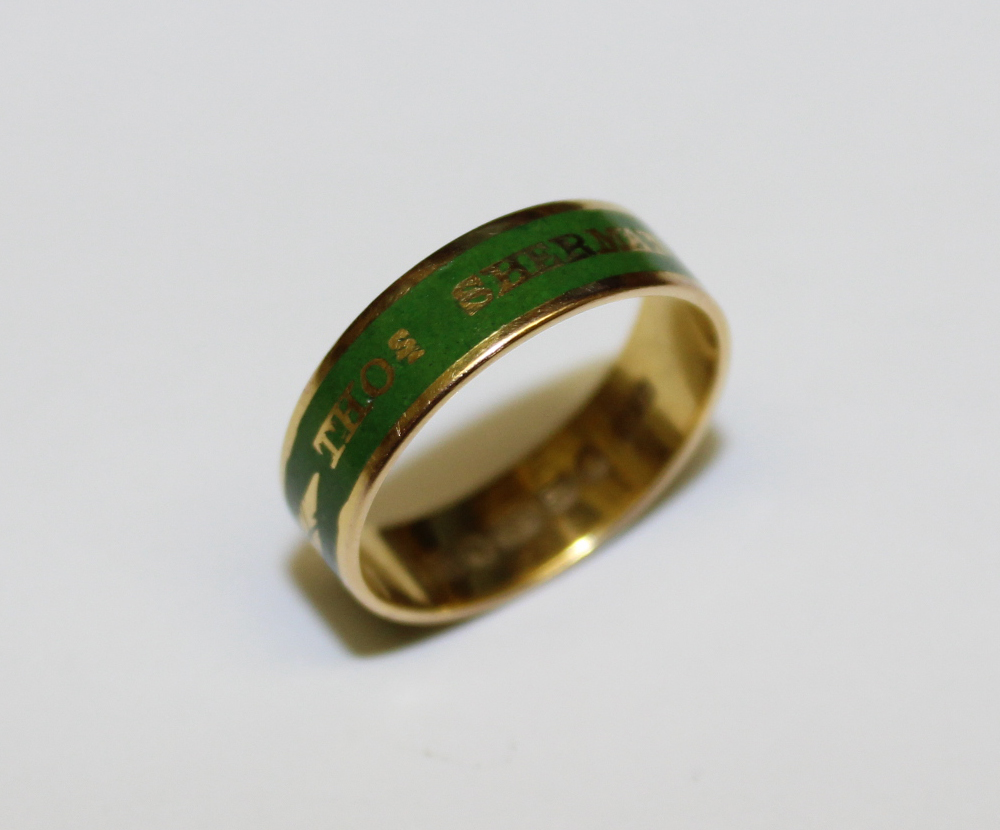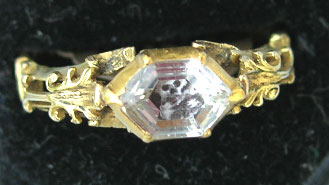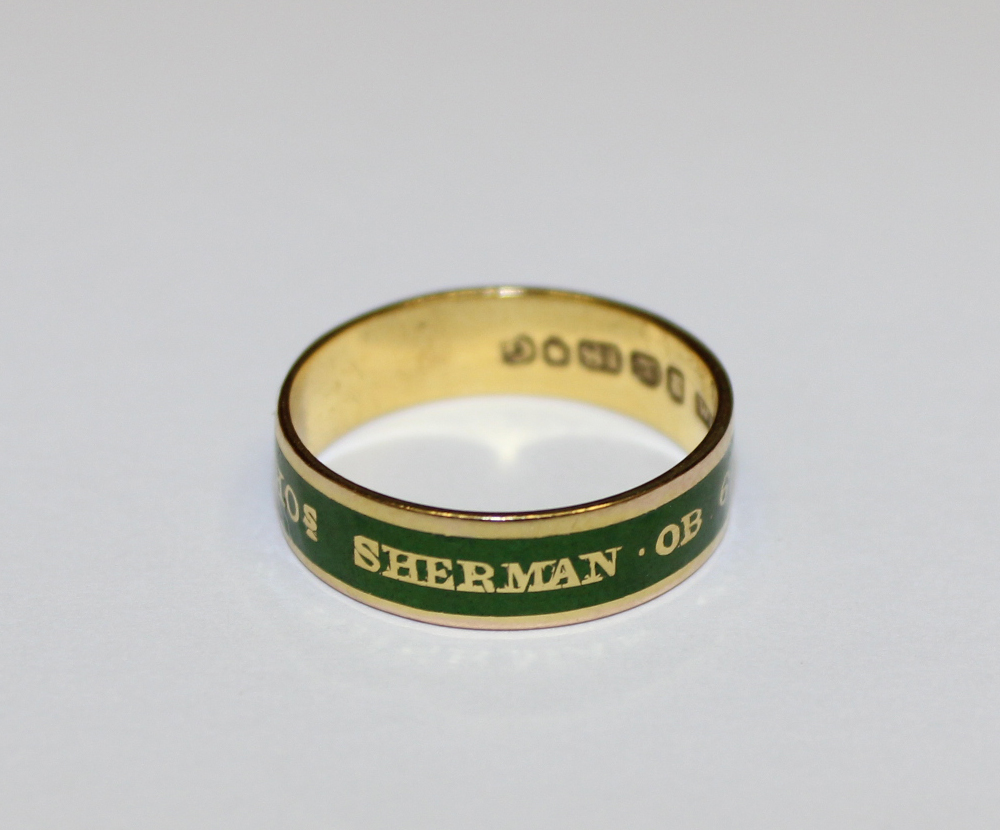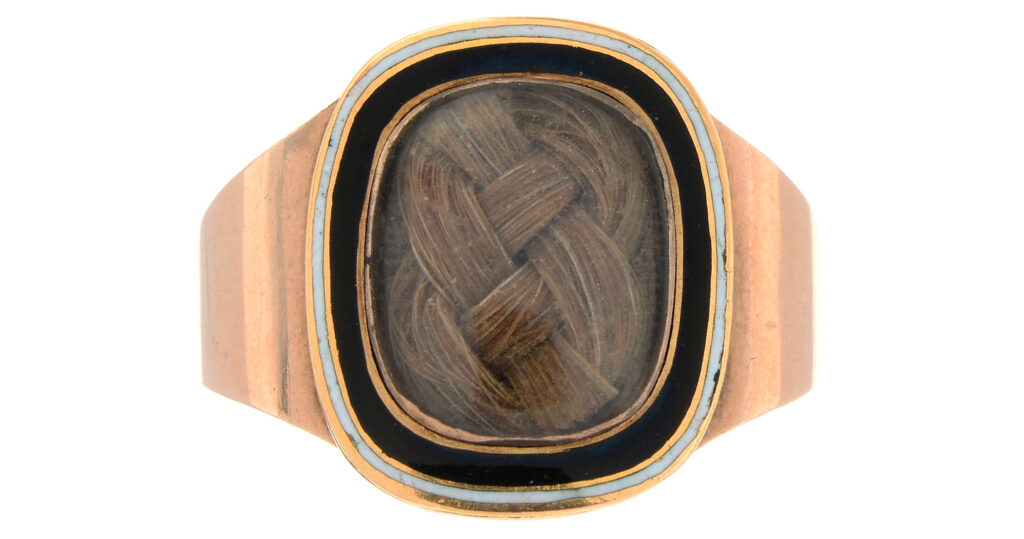1803 Green Enamel Mourning Ring: Part 2
In the first part of this article, the elements that created a green enamel mourning ring have been discovered. The use of enamel was the main identifier of love and sentimentality due to its simplicity in colour, but this could not have been the case if the Neoclassical period remained popular. A series of events, mostly due to the advent of the Romantic period, changed the perception of how the Enlightenment influenced popular culture.
Mourning culture was built on perception. The very act of identifying a person in mourning meant the creation of product. Be it as simple as the use of a mourning band at the arm or a full mourning dress for a lady, adorned in jet or wearing jewels; mourning was a product enforced through society that was concerned with growing wealth. The better the affectations of mourning, the more important the family was in society. Court ordered mandates of mourning led to the implementation of the three stages of mourning, which allowed for different costume and colour over a period of time. If one did not prescribe to this, it would be looked down upon, hence it was necessary to adhere to mourning fashion as much as possible.
This Thomas Sherman ring is important due to its use of green enamel and how that colour would be been worn in society, but how did it get that way? Through the evolution of art movements and changing cultures, today we continue to explore this wonderful mourning band.
Baroque to Rococo, Culture and Community in the Late 18th Century
The 18th century’s new focus upon the aesthetic to represent the personal led into the Neoclassical era (c.1765) and was helped through by the Enlightenment and its challenges to traditional interpretations of personal/ecclesiastical relationships. From a socio-economic perspective, the Western world was being opened up through the Americas, spurred by new technologies and industry which could increase communications and travel. Levels of society that were static in their geographic region and anchored to their family/village had access to education in rising industries and create personal finance.
With the rise of the Industrial Revolution, increased manufacture of textiles, steam power and iron making led to the need for a society that could sell these products, creating work for peddlers in towns with growing populations, creating points of sale to growing societies which had previously been smaller and more insular. With heavy investment in inventions from the early 18th century, the growth of mechanised production was rapid. Inventions, such as the John Kay’s flying shuttle (patented in 1733) doubled the output of a weaver, were financed and patented to protect their intellectual property, creating extremely high return on investment for entrepreneurs, such as Richard Arkwright and developing industrial towns, the likes of which had not been seen in modern society. Indeed, Arkwright had amassed £500,000 by his death in 1792. Considering that a very fine silk dress in the early 18th century costed £10 to £60, this amassed wealth is incredible.
Neoclassicism had become the reaction of culture towards the dominant styles of Baroque and Rocco in art and architecture through England and France, which was mainly a reaction of religious questioning. The Baroque style was dominant in its grandeur; enforcing the rule of God upon a society who could not achieve the wealth to acquire such opulent architecture that would be found in a Church or aristocratic setting, hence the presence of God within art was a constant reminder of mortality. The Age of Enlightenment allowed for liberalism in thought and the right of the individual. John Locke and Thomas Hobbs were greatly influential in 17th century English progressive thought, whose resonance would be felt throughout the 18th century. In jewellery, the Neoclassical period led to the change from the actual depiction of mortality through the Memento Mori style (skulls, skeletons, scythes, tempus fugit) were replaced with allegorical depictions from classical art. The weeping female figure next to a tomb or plinth, dressed in classical costume were more typical to find by the 1790s, when the English Enlightenment had reached its height.
What this shows is the swing against the traditional domination of a singular religious thought, to the more literal appreciation of interpersonal relationships. For rings such as this one, it is a shift towards uniformity across cultures that would previously have been separated cultures. Combined with the growing levels of wealth through industry over aristocratic birth and there is the need for a new interpretation of mourning in a single culture.
The French adoption of mourning and sentimental symbolism differed from the necessity of the British. While Court mandates enforced multiple levels of society to enter mourning stages and present the family within a mourning paradigm, the French specifically targeted the art and culture of mourning in a more focused manner from the late 18th to late 19th century, often stemming from form following fashion. As mourning styles and materials became popular (such as hairwork), it was more entitled to enter French style. Much of this is due to religion, approach to culture and how it was mandated throughout the country. The 1789 Declaration of the Rights of Man and of the Citizen offered a freedom of religion, hence no control through Roman Catholicism, or in the case of the United Kingdom, the Church of England with the monarch as its Supreme Governor. This gives greater interpretation of mourning symbolism that can relate more specifically to the wearer and not be dominated by a preordained set of values.
The 18th century welcomed in greater convention for mourning fashion and began to see the rise of the mourning industry. This became so much so that mourning dress was becoming desirable and the difference between mourning and non mourning dress was narrowing. Much of the fashion in this century was dictated by the fabric rather than the cut, and the silk industries in France and England held major influence on mourning wear because of this. It was Ordre Chronologique des Deuils de la Cour, (1765) where details of Court mourning in France were published, giving precise tailoring instructions. From their first days in mourning, men were permitted to appear in Court, unless it was after the death of a parent from whom they had received inheritance.
Widows had to wait one year and six weeks, with the first six months in black wool. Lord Chamberlain and Earl Marshall both ordered shorter periods of mourning in France and England respectively. By the 1880s in Britain, twelve weeks of mourning were ordered by the death of a king or queen, six weeks after the death of a son or daughter of the sovereign, three weeks for the monarch’s brother or sister, two weeks for royal nephews, uncles, nieces or aunts and ten days for the first cousins of the royal family. Foreign sovereigns were mourned for three weeks and their relatives for a shorter time. Mourning was divided up into First, Second and Court mourning.
Though there had been growing small scale social mobility from the late 17th century, the late 18th and early 19th centuries saw the middle classes having the opportunity to promote through society with the accumulation of wealth. Augustus Welby Northmore Pugin, a designer, architect and convert to Catholicism, saw this Industrial Revolution as a corruption of the ideal medieval society. Through this, he used Gothic architecture as a way to combat classicism and the industrialisation of society, with Gothic architecture reflecting proper Christian values. Ideologically, Neoclassicism was adopted by liberalism; this reflecting the self, the pursuit of knowledge and the freedom of the monotheistic ecclesiastical system that had controlled Western society throughout the medieval period. Consider that Neoclassicism influenced thought during the same period as the American and French revolutions and it isn’t hard to see the parallels.
In the below ring, we can see the elements of the Baroque, without the heavy, ribbon designed curvature of the band. Clean design to the shoulders also contrasts following rings.
Here, the use of the Memento Mori symbol, seen quite small, in combined with the heavy acanthus embellishment to the shoulders and the very elaborate twist to the band. One can see the continuity between the two pieces quite easily through this, as both share the same template for a mourning ring.
All these influences led to the creation of the Sherman green enamel ring. A confluence of different cultural influences that could infuse within a society, as well as the changing perceptions of what it meant to be an individual are encapsulated within such a little ring.
Rest and Rebirth
The catalysts of change are not single events. Change comes through a society carrying forward a message of change, be it a technology, fashion or religious belief. Without the influx of Protestant French talent in the 17th century, through to the 18th century Enlightenment and its interpretation of classical science and art and how that developed in the early 19th century with Romanticism, this ring for Thomas Sherman has quite a tale to tell. Mourning bands of this kind are the balance of what we understand today as being the primary identity of mourning. Black enamel bands with the ‘IN MEMORY OF’ status have their roots here, before the onset of the Gothic Revival period and the elements that were reintroduced during Victorian times. Without the streamlined shape of this ring and the simple elements of sentimentality with the mourning dedication, rings would have retained the Neoclassical shapes and designs of the previous generation, utilising allegorical depictions of love through the urn, willow and mourning female character. Retracting design as a template to these basic forms allowed for them to grow in a new direction and what we know today as the black enamel band grew from this simple design.





